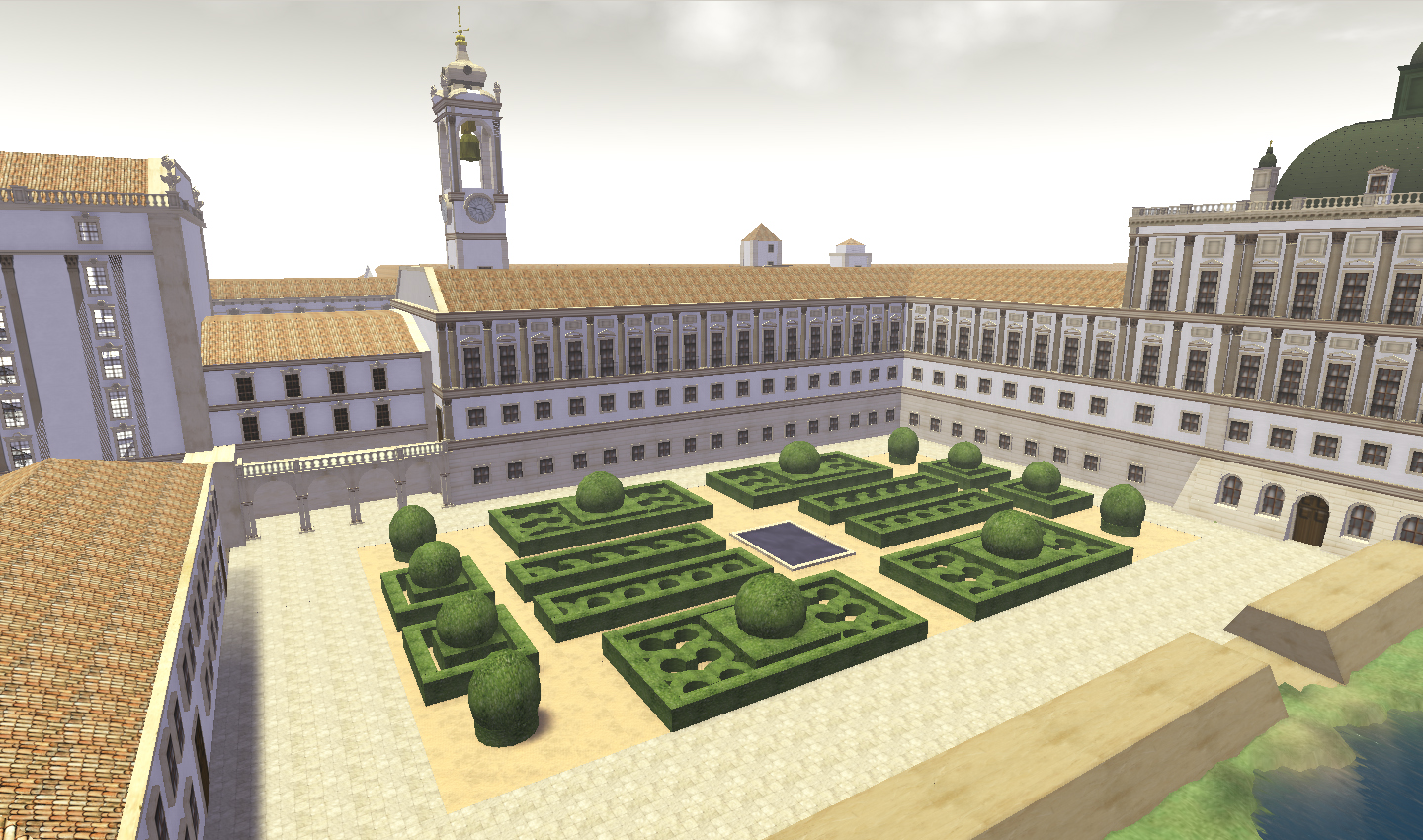 I’m not dead yet, I’m sadly just too busy to blog about things… but have lots of pending ideas to write about 🙂
I’m not dead yet, I’m sadly just too busy to blog about things… but have lots of pending ideas to write about 🙂
So, what I’ve been busy with? Mostly about getting some things done for an international workshop on virtual archaeology (if you’re in Lisbon on Friday with little to do, feel free to drop by — attendance is free, most sessions will be in English, and there are really some great speakers from the Rome Reborn project as well as researchers from King’s Visualisation Lab). This required some extra, free work from some of our teams at Beta Technologies for our 5-year-old, almost-zero-funds project to recreate the city of Lisbon just before the earthquake of 1755 hit it, namely from our Creative Director, Moon Adamant. It’s not just about buildings: we wish to recreate typical baroque events that people will be able to attend as well. Fancy a night at the Opera House which had the largest stage in the world before the earthquake ruined it? You will be able to do so. What fashion did the Court wear for attending a King’s crowning ceremony in the 18th century? Don’t just read about it; log in, pick your clothing style, and participate. That’s the kind of thing we wish to do… one day. Assuming this project will ever get some funding!
Oh, and for now it’s being run on Beta Technologies’ OpenSim grid. There is sadly no funding to have it on Second Life®. You might be able to do a Hypergrid teleport to it from any other Hypergrid-enabled OpenSim grid (or even an OGP teleport from LL’s Preview Grid), but I haven’t tried that for a while…
 Of course I’m not a modeller, but my meagre contributions to that project was mostly to make sure that the project’s site was minimally operational (integrating the work from a designer with the ideas of the researchers into a consistent whole). And when trying to get the site to be viewable by a plethora of computers and operating systems, problems pop up… So, to get a simple WordPress site up and running, it meant a lot of nightmares, and installing Parallels 5 on my old iMac — and finding that I can almost use Blue Mars in it (yay Parallels!). I’m sure that if I had a slightly more powerful iMac, I might even not crash after the first 2 minutes of seeing Caledonia… Anyway, why do I need Parallels? Because some embedded Flash on that site just looked wrong under Internet Explorer 8, and I needed a Windows machine to test it…
Of course I’m not a modeller, but my meagre contributions to that project was mostly to make sure that the project’s site was minimally operational (integrating the work from a designer with the ideas of the researchers into a consistent whole). And when trying to get the site to be viewable by a plethora of computers and operating systems, problems pop up… So, to get a simple WordPress site up and running, it meant a lot of nightmares, and installing Parallels 5 on my old iMac — and finding that I can almost use Blue Mars in it (yay Parallels!). I’m sure that if I had a slightly more powerful iMac, I might even not crash after the first 2 minutes of seeing Caledonia… Anyway, why do I need Parallels? Because some embedded Flash on that site just looked wrong under Internet Explorer 8, and I needed a Windows machine to test it…
Speaking of WordPress… WP 3.0 Beta 2 is out, and, as I reported elsewhere, I’m using it now for our corporate site and blogs (which also needed an overhaul — thanks to SignportMarv Martin, who did the original implementation of that design, for the useful tips in fixing some CSS bugs). So much is “under the hood” in WP 3.0 that you should really read about it elsewhere. In my case, I was just concerned about two things (for now): unifying WP and WP MU under the same system and finally get some pretty decent menu/navigation system. With the WP/WP MU integration and the menu system, plus cool things like BuddyPress, WordPress 3.0 is just one feature short to replace Joomla as a general-purpose CMS (WP 3.0’s backoffice is slowly removing the word blog from certain areas and just use the more generic site): simple-to-configure areas for registered users. Aye, you can do those under WP, but they’re a pain, not very secure, and require a lot of programming — or even buying some plugins! I hope that WP 3.1 implements that in an easy way, fully integrated in the backoffice with a consistent look, and Joomla can be driven into oblivion. The next one to tackle would be Drupal 🙂 but that task is much more staggering; Drupal is a far more powerful engine. Perhaps for WP 4.0 in 2013 🙂
After going through the usual pains of seeing what works in which browser rendering engine, I certainly started to take an interest in HTML5 — and no, it was not because Steve Jobs has been bashing Flash and pushing HTML5 instead. It’s just because HTML, after all those years, seems to be coming back to its roots. If you are old enough to have discussed the <center> tag with Tim Berners-Lee on USENET, you might remember the big issue when Mosaic introduced images on a web page — should Web pages describe content or design? For well over a decade, there seemed to be a tug-of-war fight as web designers struggled with tables to get a page to look exactly like they wished. CSS tended to help a lot towards that goal, but something was lost in the process: pages are a jungle of <div>‘s and you hardly know which one refers to which kind of content.
HTML5 proposes to change all that by creating cool new tags which are all about content — or, more precisely, what is called the semantic Web these days. The idea is that you should be able to look at a glance at some HTML and identify, on a blog, where the headers are, where the article is, where the sidebar or the navigation menu is, and so forth. The “you” here means mostly web crawlers for search engines and other automated tools that slice and dice content. Tim Berners-Lee, thinking about HTML as a way for researchers to collaboratively use the Web for publishing research papers, only worried about headers and little else (well… slightly exaggerating here! But you know what I mean: early HTML was supposed just to describe an academic article, not a blog about Second Life… or Facebook). HTML5, in a sense, brings the whole page code back to 1993. CSS3 is powerful enough to keep designers happy; HTML5 markup should be more compact and address semantics. It seems exciting!
Oh, and as a side note, it’ll kick Flash out of the picture too. Well, at least Flash video containers, they will be useless except on Internet Explorer (but Microsoft promises to make IE9 compliant with HTML5, so there is still hope. I guess nobody likes to pay Adobe for licenses). HTML5 handles falling back to obsolete rendering engines much more nicely. And, well, it runs on the iPhone too… and with luck, one day, we’ll see it working on Linden Lab’s in-world browser as well.
Besides all that, there is a super-secret project I’m also working on, which is eating up all my spare time very quickly… eating up so much of it, in fact, that my PhD supervisor is already grumbling that I don’t publish enough articles on my own research, and I’m thus sentenced to academic hell… specially because if might mean a rejection of a scholarship I’m supposed to be applying to. And of course I still have a third job, the only one that regularly pays something, enough to pay my power, water, and Internet bills. The irony of all this is that I have to work twice as hard to get enough money to survive, so that I can afford to study as well, but the extra work gives me little free time to dedicate to study & research, meaning I don’t do enough to be worth publishing, thus diminishing my chances to apply for a scholarship. Somehow I think that the whole world is upside down: if I had the scholarship first I could drop my jobs and just do research; but noooo, the academics think exactly in the opposite way: work first, prove your worth, and we might grant you a scholarship. Perhaps. And because of that perhaps it means that, with clients taking more and more time to decide (and even longer to pay!), I need to get a third job, and quickly, because my money is running out…
But, as my Buddhist teachers would say, this is why the world sucks 🙂 And speaking of teachers, we’re getting another one over this weekend as well… so, yes, I will be very busy and completely unavailable during the next few days.






